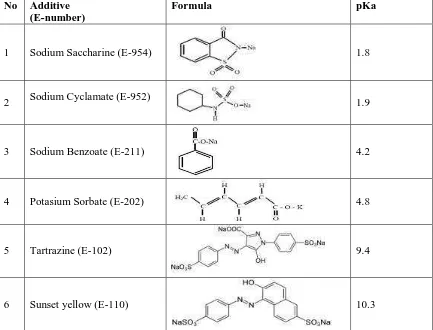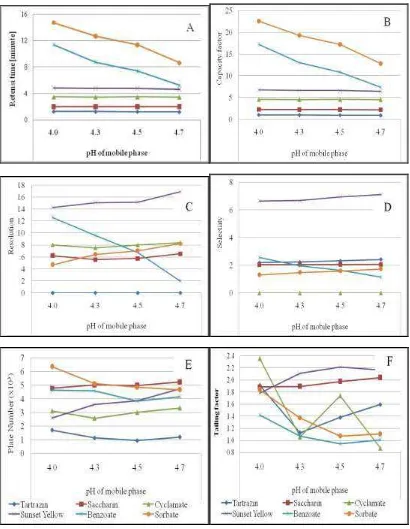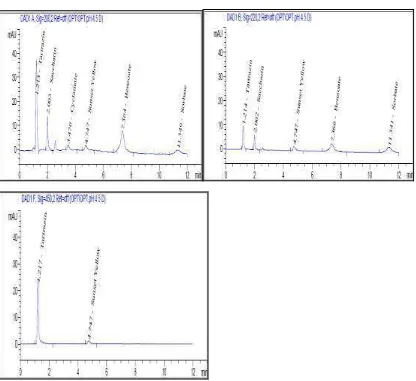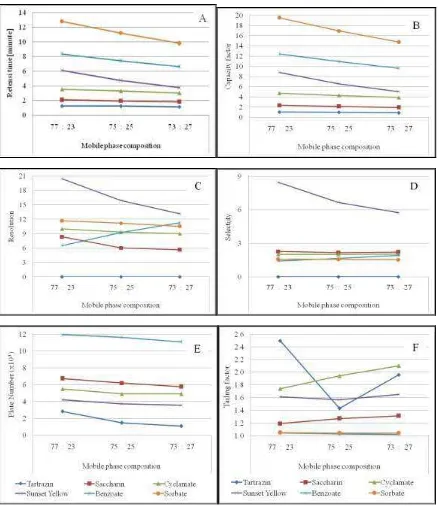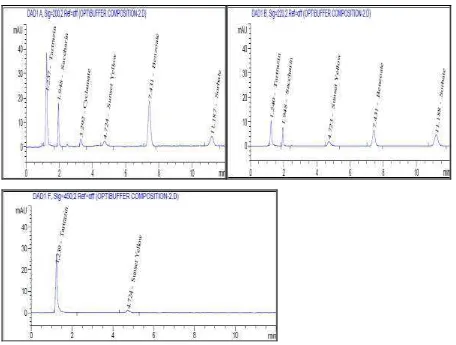Optimization of Mobile Phase for Simultaneous
phase of one of the compounds can not be used as an option for separation of the compound. Suitable mobile phase, both solvent type, composition and pH of the mobile phase are the factors that determine success in separation of the compound. The study was conducted to determine the composition and pH of the mobile phase in the development of a mixed separation method from food additives containing sodium saccharin, sodium cyclamate, sodium benzoate, potassium sorbate, tartrazine and sunset yellow. Research using high performance liquid chromatography, reversed phase with instrument: UFLC 1290 DAD(Agilent), C18 column 100 mm x 4.6 mm x 3.5 μm (Agilent). The results showed that pH and optimum mobile phase composition were 4.5 and 75: 25 (v / v). Parameter of optimization includes the capacity factor, plate number, resolution, selectivity and tailing factor meet the requirements of analysis.
Key words : UFLC, pH, Composition, Food Additives.
Introduction
The selection of the mobile phase can only be done by trial and error until the desired chromatogram is obtained. The mobile phase usually consists of a mixture of solvents haven excellent elution and resolution of the compounds in the sample. Elution ability and resolution are determined by the polarity of the solvent, the polarity of the stationary phase and the properties of the sample component. The normal phase, the stationary phase is more polar than the mobile phase will have an increased elution ability with an increase of the solvent polarity. The reversed phase, the stationary phase is less polar than the mobile phase will have decreased elution ability with an increase of the solvent polarity1,2.
Optimization are an attempt to get a better separation, fast analysis, improving sensitivity and save costs. The methods development of chromatography are done so that the performance of simple, better, precise, accurate, economical, selective, sensitive, and specific3,4.
Table 1. List of Additives according to the European Commission and the acid dissociation constants of food additives 6,7,8,9,10
No Additive (E-number)
Formula pKa
1 Sodium Saccharine (E-954) 1.8
2 Sodium Cyclamate (E-952) 1.9
3 Sodium Benzoate (E-211) 4.2
4 Potasium Sorbate (E-202) 4.8
5 Tartrazine (E-102) 9.4
6 Sunset yellow (E-110) 10.3
The mobile phase composition gives an indication of polarity. The polarity of the compound in the mobile phase provides an important role in the separation 1,2. The composition and pH of the mobile phase of one of the compounds can not be used as an option for separation of the compound, can only be used as a separation reference. Suitable mobile phase, both solvent type, composition and pH of the mobile phase are the factors that determine success in separation of the compound11,12,13. The mobile phase of phosphate buffer and methanol are one of the most commonly used motion phases in routine analysis.
The determination of sodium saccharin, sodium cyclamate, sodium benzoate, potassium sorbate, tartrazine and sunset yellow can be carried out in the buffer phase of pH 4.0 to pH 6.0 with a certain organic phase composition14,15,16,17,18,19. The six compounds have a certain mobile phase composition, it would be better if pH optimization and composition of the mobile phase are applied.
Experimental
Chemicals and Instruments
The materials used are methanol grade HPLC (E. Merck), potassium dihydrogen phosphate anhydrous (E. Merck), orthophosphoric acid (E. Merck), aqua pro injection (Ekapharmindo Putramas) sodium saccharin, sodium cyclamate, sodium benzoate, potassium sorbate, tartrazine, and sunset yellow (Sigma Aldrich).
Preparation of mobile phase
The phosphate buffer solution was prepared from potassium dihydrogen phosphate anhydrous 10 mM by adding orthophosphoric acid 10 mM. The composition of the mobile phase are adjusted from a mixture of phosphate buffers and methanol.
Working standard solutions
Single stock solution of tartrazine, sunset yellow, saccharin, cyclamate, benzoate and sorbate were prepared at a concentration of 1000 ppm, respectively. The working solution was prepared by diluting the stock solution so as to obtain a mixture of tartrazine, saccharin, cyclamate, sunset yellow, benzoate and sorbate at 10 ppm, 1 ppm, 75 ppm, 5 ppm, 3 ppm, 6 ppm, respectively.
Experimental procedures
Standard solution was filtered with a 0.45 μm PTFE syringe, sonicated for 15 minutes, injected 5 mL, flow rate of 1.0 ml/min, the column temperature 30oC, void volume of 30% and wavelengths of 200 nm, 220 nm and 450 nm; mobile phase pH test of 4.0; 4.3; 4.5 and 4.7; composition of phosphate buffer and methanol test of 73 : 27 ; 75 : 25 and 77 : 23. Subsequently been selected the conditions that give optimum results with the parameters of capacity factor, plate number, resolution, selectivity and tailing factor.
Results and Discussion
Optimization of pH mobile phase
The pH mobile phase optimization results obtained data in the form of retention time (Rt), capacity factor (k’), theoretical plate number (N), resolution (Rs), selectivity (α) and tailing factor (Tf). The effect of buffer pH on optimization parameters can be seen in Table 2 and Figure 1.
Table 2 and Figure 1 gives information that the separate compounds are poor in the phosphate buffer
phase phases of pH 4.7; because the sodium benzoate resolution is smaller than that allowed (Rs ≥ 2)1,2 . This provides information of ionization of sodium benzoate (pKa = 4.2) in the buffer phase of pH 4.7; so that retention time becomes faster and resolution are poor (Figure 1). Sodium saccharin and sunset yellow have tailings and sodium cyclamate undergoing fronting of phosphate buffer pH 4.7 (Table 2). This gives information about the ionization of sodium saccharin (pKa = 1,8), sodium cyclamate (pKa = 1.9) and sunset yellow (pKa = 10.3) so that the chromatograms of sodium saccharin and sunset yellow have tailings, whereas sodium cyclamate undergoes fronting (Figure 1).
Table 2. Effect of pH buffer to parameter optimization
poor. Sodium cyclamate undergoes tailings with a tailings factor value of 2.357 (Table 2). This information as an indication of ionization of sodium cyclamate at phosphate buffer phase pH 4.0 causes partition in the phase of motion are poor then the chromatogram form into tailings.
The compounds are well separated in the mobile phase of the phosphate buffer pH 4.3 and pH 4.5 and meet the requirements1,2. Tailings occur at sunset yellow (pKa = 10.3), both in the mobile phase of phosphate buffer pH 4.3 and pH 4.5. This shows that yellow sunset ionization causes partitions in the mobile phase to be poor. The potassium sorbate capacity factor at pH 4.3 (k = 19.30) was greater than pH 4.5 (k = 17.20), so the analysis at pH 4.5 was better than at pH 4.3. Therefore, the phosphate buffer solution used for the study should be at pH 4.5.
The best results used the mobile phase of phosphate buffer: methanol (pH = 4.5) and were in the range performed by previous researchers14,15,16,17,18,19. Differences in pH occur due to the organic mobile phase, the type of buffer used and the components of the compound to be separated are different. Chromatogram pH optimization results of the mobile phase can be seen in Figure 2.
Figure 2. Chromatogram of the results of the mobile phase pH optimization
Optimization of mobile phase composition
The optimized mobile phase is phosphate buffer pH 4.5 and methanol at composition of 73: 27; 75: 25 and 77: 23 (v/v). The effect of mobile phase composition on the optimization parameter in the form of data (Table 3) and Figure (Figure 2).
Figure 3 shows that the retention time in the phosphate buffer phase phosphate composition pH 4.5 and methanol 77: 23 are slower than in the 75: 25 and 73: 27 compositions. The methanol composition is increasingly causing the capacity factor, the number of theoretical plates, the resolution and the selectivity experienced Decrease, except for resolution and selectivity of benzoate.
Figure 3 shows that the capacity factor of benzoate (pKa = 4.2) decreases due to increased solubility as the methanol fraction increases. Benzoate is not fully ionized in phosphate buffer phase pH 4.5. Resolution and selectivity of benzoate increased, indicating that the separation of benzoate from the mixture was more perfect. Decreased capacity factors of saccharin, cyclamate, sorbate, tartrazine and sunset yellow lead to decreased resolution and selectivity. This is due to the decrease in the viscosity of the mobile phase, not the increase in the solubility of the compounds in methanol because the compounds are ionized in the polar phase.
The results of the study met the requirements of optimization parameters1,2, but cyclamate and tartrazine had tailings in phosphate buffer phase pH 4.5 and methanol at a ratio of 73: 27 and 77: 23 (v/v). Cyclamate and tartrazine can not partition in the mobile phase of the comparison. Therefore, the analysis is better done in phosphate buffer: methanol 75: 25 (v/v). The optimized chromatogram can be seen in Figure 3.
Figure 3. Results of chromatograms from the optimization of mobile phase composition
Conclusion
The optimization result of the method development was obtained that the optimum mobile phase composition was 75: 25 (v/v) with pH 4.5 at the wavelength of the analysis of 200, 230 and 450 nm; flow rate 1.0 ml/min, column temperature 30oC. The optimization parameters include capacity factor, theoretical plate number, resolution, selectivity and tailing factors meeting the requirements of the analysis
References
1. Snyder L.R, Kirkland J.J and Dolan J.W, Introduction to Modern Liquid Chromatography, A John Willey & Sons, Inc. Publication, 2010, 20-83, 532-542, 887-890.
2. Dong M.W, Modern HPLC for Practicing Scientists. A John Willey & Sons, Inc. Publication, 2006, 1-13.
3. Suprianto, Effendy De Lux Putra, and Siti Morin Sinaga, Optimization of Volume Void and Wavelengths at Simultaneous Determination Method Development of Sweeteners, Preservatives and Dyes by UFLC, International Journal of ChemTech Research, 2017,10(1): 89-97.
5. Xavier Subirats, Marti Roses and Elisabeth Bosch. On the Effect of Organic Solvent Composition on the pH of Buffered HPLC Mobile Phases and the pK a of Analytes—A Review. J. Separation & Purification Reviews, 2007, 36: 231–255.
6. N. Dossi, R. Toniolo, S. Susmel, A. Pizzariello, G. Bontempelli. Simultaneous RP-LC Determination of Additives in Soft Drinks. Chromatographia. 2006, 63(11/12): 557–562.
7. Windholz, M., Budavari, S., Stroumtsos, L.Y., dan Fertig, M.N. (1983). The Merck Index: An Encyclopedia of Chemicals, Drug and Biologicals, Edisi 10. USA : Merck and Co. Inc. 1983. Hal. 352, 545, 575, 1107, 1149, 8830.
8. European Food Safety Authority. Scientific Opinion on Safety and Efficacy of Sodium Benzoate, Propionic Acid and Sodium Propionate for Pigs, Poultry, Bovines, Sheep, Goats, Rabbits, Horses. EFSA Journal, 2012, 10(5): 2681.
9. European Food Safety Authority. Scientific Opinion on the Re-evaluation of Sunset Yellow FCF (E 110) as a Food Additive. EFSA Journal, 2009, 7(11): 1330.
10. European Food Safety Authority. Scientific Opinion on the Re-evaluation Tartrazine (E 102). EFSA Journal, 2009, 7(11): 1331.
11. Gowekar N.M and Wadher S.J, Simultaneous Estimation Of Formoterol Fumarate Dihydrate and Fluticasone Propionatein Dry Powder Inhalation Formulation By RP-HPLC, International Journal of PharmTech Research, 2016, 9(1), 164-170.
12. Gorle A.P and Shinde J.S., Development and Validation of Stability Indicating Assay Method of Ofloxacin in Bulk and Pharmaceutical Dosage Form by RP-HPLC, International Journal of PharmTech Research, 2016, 9(4), 289-298.
13. Ravichandran S and Keerthibala K, Development and Validation of RP-HPLC Method for the Simultaneous Estimation of Paracetamol, Domperidone and Esomeprazole Magnesium in Tablet Dosage Form, International Journal of PharmTech Research, 2016, 9(7), 200-206.
14. Jankana Burana-osot, Leelawan Arunsingkharat, Matsarin Naksuk, Supapan Naungnamjai and Thanapon Saetun. Validation of a HPLC Method for the Determination of Benzoic Acid and Sorbic Acid in Noodles. Chiang Mai J. Sci. 2014; 41(2): 370-382.
15. Khosrokhavar, R., Sadeghzadeh, N., Amini, M., Khansari, M.G., Hajiaghaee, R., dan Mehr, S.E. Simultaneous Determination of Preservatives (Sodium Benzoate and Potassium Sorbate) in Soft Drinks and Herbal Extracts Using High Performance Liquid Chromatography (HPLC). Journal of Medicinal Plants, 2010, 9(35): 80-87.
18. Burge Asci, Sule Dinc Zor and Ozlem Aksu Donmez, Development and Validation of HPLC Method for the Simultaneous Determination of Five Food Additives and Caffeine in Soft Drinks. International Journal of Analytical Chemistry 2016(5):1-8.
19. Qinghua Yan, Li Yang, Xiaoqin Ma and Huigen Feng, Simultaneous Determination of Six Food Additives in Drinks by High Performance Liquid Chromatography Coupled to Diode Array Detector Detection, J. Chem. Soc. Pak., 2013, 35 (4), 1060- 1065.
